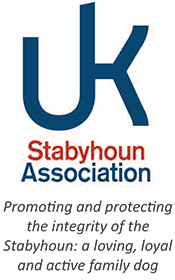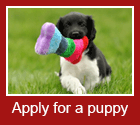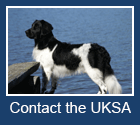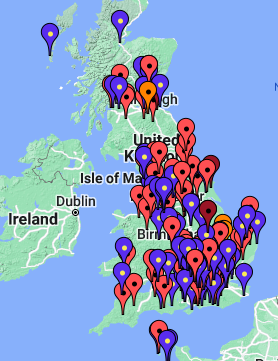UK Stabyhoun Association members, Helen Withey, Janice Vittachi, Hannah Woods and Christina Savage share their experiences and tips on breeding with a Stabyhoun…
Q: Why did you choose to breed?
Helen: I was looking for a new challenge – having bred and worked Rottweilers to the gun for 30 years and then Tollers for 15 years. I found the Stabij and, having never owned an HPR (Hunt, Point & Retrieve), I thought it would be great to have a go at working one, and maybe even establishing a working line in the UK.
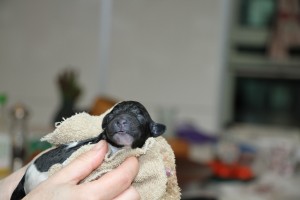 Hannah: I first chose to breed because I wanted to contribute towards a healthy and positive future for the breed I loved, which for me first were Shelties. There is a history in most breeds of people breeding for purposes other than health and welfare. I really wanted to do my bit to breed in a responsible way.
Hannah: I first chose to breed because I wanted to contribute towards a healthy and positive future for the breed I loved, which for me first were Shelties. There is a history in most breeds of people breeding for purposes other than health and welfare. I really wanted to do my bit to breed in a responsible way.
When we heard about the UK Stabyhoun breeding program, I was drawn to the conservationist and ethical approach that the UKSA takes, and really wanted to be involved.
Janice: As was common in the 60s and 70s, the pets I grew up with were allowed to breed at will and, as a kid, I loved being part of the process. I had always hoped to have that experience again as an adult. As a result, I was ‘chosen’ by the Ameri-Can Stabyhoun Association to be Rikje’s owner since it was hoped that she would produce at least one litter for the North American gene pool. I seemed to be a likely bet to breed her.
Also, I love puppies! As a breeder, I get to play with puppies to my heart’s content… and then give ‘em away. I love that!
Christina: Having worked in animal rescue for many years, I wouldn’t breed unless there was an established demand for puppies. But with a rare breed like the Stabyhoun, it is vital that as many healthy dogs as possible are bred from. I wanted to do my bit for the breed I love.
Q: What is the mating process like?
Christina: Jelske’s first mating was very straightforward. But it did involve quite a few tense days of waiting for the right time, and required a quick turn-around once that day arrived. We even had to postpone our holiday for a week. If you really want puppies, you have to be be prepared to move any non-essential appointments around.
Helen: I think mating a dog is easy and I always leave it to nature. I introduce the bitch to the dog as soon as she is showing signs of being receptive – then I just leave them to it and keep a close eye. If they want to mate they will, if not I will just let them spend time together each day until the dog shows no more interest. What will be will be. If I do get a successful mating, I will repeat it 48 hours later to have the best chance of getting puppies.
Janice: I spend a lot of time wondering: Have I timed it right? Will it take? Will she carry to term?
Rikje has been mated both naturally and by Artificial Insemination. While a natural mating takes some of the pressure off (it’s all on the dogs!), I find the tension similar in each case. But once the mating is achieved the strain eases completely – at least for me. From that point onwards, it’s just a matter of letting nature run her course, and that is something I’m supremely comfortable doing!
Hannah: I found the first ever mating a very strange experience. Some females don’t want to stand for the first bit, others don’t like the ‘tie’. Mieke stood like a pro for her mating – first timer that she was – but did get a little stressed at first with the ‘tie’. The best thing is to stay calm and keep the dogs where they are. They soon settle.
Q: What is it like to care for a pregnant dog?
Janice: For most of a bitch’s pregnancy, there’s so little change in her that it’s easy to forget she may, in fact, be pregnant. I’m not sure if it’s true for all breeds, but one of the sure signs of pregnancy is that a Stabij becomes incredibly soppy. It’s almost shocking how much cuddling a pregnant bitch needs. Like humans…
Good nutrition is key to getting healthy and well-developed little bundles of fuzz. Give mum lots of extra calcium through the first two-thirds of the pregnancy, then remove all calcium until after whelping. Omega 3 fatty acids and probiotic supplements are good, plus lots of fresh water.
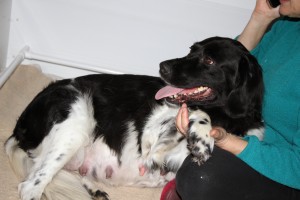 Helen: Do everything as normal until about week five when you start increasing the food and administering worming treatments as advised by your vet. I introduce the bitch to the whelping box at week seven – making sure it is in a quiet area of the house where she can get used to spending time alone and sleeping in the box at night. Then set up a camp bed for yourself and make sure you have your vet’s emergency number to hand just in case. If it is your first litter don’t panic. Bitches can show signs of labour for 48 hours before delivering the first puppy, so be patient. Unless she is pushing or the waters have broken, just relax and keep her company.
Helen: Do everything as normal until about week five when you start increasing the food and administering worming treatments as advised by your vet. I introduce the bitch to the whelping box at week seven – making sure it is in a quiet area of the house where she can get used to spending time alone and sleeping in the box at night. Then set up a camp bed for yourself and make sure you have your vet’s emergency number to hand just in case. If it is your first litter don’t panic. Bitches can show signs of labour for 48 hours before delivering the first puppy, so be patient. Unless she is pushing or the waters have broken, just relax and keep her company.
Hannah: Keep them fit! Stay in their usual routine for the first four to five weeks, then listen to her as she progresses further through the pregnancy. If she’s getting tired, let her rest. As time moves on, she’ll need feeding more food but in smaller portions, and she’ll need the toilet more frequently. Pregnant dogs are definitely extra sweet and cuddly – lots of hugs needed.
Make sure she doesn’t get bumped around or exposed to anything harmful from the very beginning, including strong cleaning and other chemical products. Her body can cope but unborn pups are very susceptible.
Q: Whelping: What is it really like?
Christina: Waiting for the first puppy to appear is tense, and trying to guess when the last one has been born is always tricky.
More than once I have been surprised by a little ‘bonus’ puppy after we thought it was all over. Most recently when Rikje’s 10th puppy arrived just before midnight!
Take notes about everything! At 3am you might struggle to remember what mum’s temperature was five hours ago, but that could be important.
It can feel like there is constantly a decision to be made about what to do, or not to do, but try to be patient. There can easily be several hours between puppies. Have a vet on call for sensible advice and reassurance but trust nature most of the way.
Ideally, ask someone who has experienced whelping before to be with you. It could make a difference.
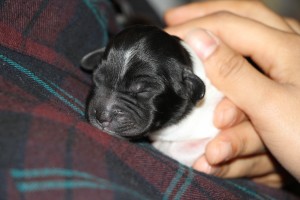 Hannah: I find it nerve-wracking, but if all goes well it’s amazing. I’ve had both clean and messy whelpings – but be prepared for the mess and goo!
Hannah: I find it nerve-wracking, but if all goes well it’s amazing. I’ve had both clean and messy whelpings – but be prepared for the mess and goo!
Preparation is really important: Have everything that you might need out and ready beforehand, including replacement formula. You will not have time to go rooting for things if something goes wrong. Do your research on signs to look for if something is going wrong, and let your vet know when she’s going into labour, so they can be prepared too.
Once you’ve done all that…relax! Keep an eye on your girl and let her progress in peace. All dogs whelp slightly differently and if she’s getting on just fine there’s no need to worry.
Make sure all placentas are accounted for – you need to know if she has retained any so you can check that they are expelled later on. On rare occasions, this may otherwise require some veterinary assistance.
Janice: Whelping is a big ol’ green mess! Have lots of puppy pads handy. If you can manage to slip one under the bitch before each pup emerges, it will help minimise the clean-up.
Obviously, it’s a good idea to read up on whelping beforehand so you are prepared for whatever happens. But the best plan is to have a more experienced breeder around for the duration of the whelping.
Helen: Whelping is messy and stressful but also the most fantastic thing to witness when all goes well.
Q: How do you look after mum and pups in the first days and weeks?
Hannah: Keeping the puppies warm is essential – they cannot regulate their own body temperature and are very vulnerable to cold. A pressure sensitive heat mat in the middle of the box is a good idea; mum can then move off it if she gets too hot. Someone should be with the puppies all the time to spot immediately if any are getting squashed or rolled on, especially in a bigger litter.
You will probably need to drag mum away to use the toilet for the first few days at least – she won’t want to leave them! Throwing a light warm blanket over the puppies while you take her out will stop them squeaking too much while she’s gone.
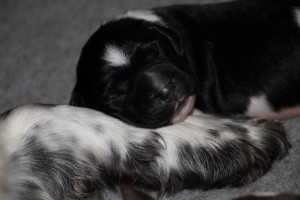 Christina: I’d recommend keeping everything nice and quiet. If this is your dog’s first litter she is still adjusting and even the most natural mum needs to learn from experience. Don’t be tempted to invite friends and family around to meet the brood – there will be plenty of time for that later on.
Christina: I’d recommend keeping everything nice and quiet. If this is your dog’s first litter she is still adjusting and even the most natural mum needs to learn from experience. Don’t be tempted to invite friends and family around to meet the brood – there will be plenty of time for that later on.
Helen: Make sure mum is getting plenty to eat as she is now feeding a whole family. The room should be well heated as the pups won’t regulate their own body temperature until they are three weeks old. During this time mum will keep them clean and well fed.
Janice: One of the biggest post-partum threats is eclampsia – a life-threatening drop in blood calcium levels that occurs in nursing mothers. You can minimise the risk of eclampsia by managing the bitch’s calcium intake, but it’s still necessary to watch out for the signs, especially if it’s a large litter.
Other risks are infection in the mammary glands and the uterus. Any of these can potentially be serious so familiarise yourself with the signs.
Q: When does socialisation begin?
Christina: Technically from day one when you start stroking and handling the puppies several times each day. This hard-wires the smell and sensation of humans into their brains. For us, visitors start arriving at week three, and by week four they can begin to go outside if the weather is nice.
With Jelske’s litter, our house was like Euston station for a short while! We did have a rule of only one visit per day though. That way, both mum and puppies were allowed time to relax and digest all the new impressions before the next visit. Socialisation is vital with all breeds, but it is particularly important when it comes to the more sensitive breeds like the Stabyhoun. So keep an open door policy and enjoy the interaction between puppies, children and adults.
Janice: Before their eyes even start to open I have already begun introducing them to sounds such as the hoover and musical instruments, along with various smells like orange peels, bedding from other pets and so on.
Once the socialisation period actually begins around four weeks, they’re ready to be introduced to all kinds of experiences.
Handle them. A lot. Look into their eyes, ears and mouths. A lot. Challenge them early and often: Give them different textures to walk on like a soggy towel and pebbles. Show them different people and pets, a mirror, toys that move and make sounds, the outside, the lead… the possibilities are endless – and always entertaining!
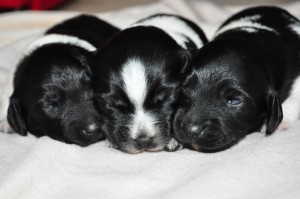 Helen: Socialisation starts from day one – handling the pups to check they are ok and well fed. After about day 10 their eyes will start to open and they become more mobile so you can start to introduce some toys for them to interact with. From four weeks onwards they can start to go outside and explore the big world, but make sure they are not out long enough to get chilled.
Helen: Socialisation starts from day one – handling the pups to check they are ok and well fed. After about day 10 their eyes will start to open and they become more mobile so you can start to introduce some toys for them to interact with. From four weeks onwards they can start to go outside and explore the big world, but make sure they are not out long enough to get chilled.
When they are eating well, let them feed in different areas too.
Introduce them to different noises such as the washing machine, hoover, radio and television. Let them get used to walking on different surfaces and also start to brush them with a soft brush. The more you do with them at an early age the easier it will be for them when they leave home.
Hannah: Puppies that are raised in a home environment benefit from exposure to everyday sounds from the beginning. You won’t be short of people wanting to visit and meet the puppies, so human socialisation will be easy too!
Visit www.thepuppyplan.com for more information about what to do and when.
Q: When do you wean puppies?
Helen: At about two to three weeks I start introducing solid food which is either some very fine raw mince or well-soaked kibble. The hard work now really starts as they will be more mobile and making more of a mess. As soon as you have cleared up one bit of mess, they wake up and it all starts again.
Increase their food according to how hungry they are, and make sure no one gets pushed out of the way and goes hungry. Around weeks four and six, the puppies should also be given worming treatments. Take care to think about what you are feeding them. It needs to be species appropriate and contain all the nutrition they need. That means no Weetabix! And choose something that the new owners can easily buy in pet shops or online.
Christina: When they are three weeks old, we begin offering them the same raw food that we feed the mum, three times per day – with a bit of warm water mixed in to start with. They will eat when they are ready and as much as they need.
With Jelske’s pups it was a quick introduction; they all loved it! And two of my buyers, Cathy and Ben, got to witness their first meal which was lovely.
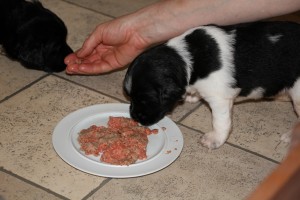 Hannah: I start introducing my puppies to solids when they begin showing an interest in mum’s food.
Hannah: I start introducing my puppies to solids when they begin showing an interest in mum’s food.
We feed our dogs on a raw diet so I give the pups a chicken wing each to have a good gum on! They don’t get anywhere with it, but they get used to the taste and it gets their mouths chomping. Next comes a small amount of mince, gradually increasing it as their desire for solid food grows. This is where the hard work starts – mum stops cleaning up after them so get used to a world of puppy poo!
Janice: I have very little to do with the weaning process. In the first few weeks, it’s all up to the mum. I will, however, introduce the pups to solid food when they are about four weeks old.
Q: What’s it like having people coming to view puppies?
Christina: It is completely wonderful. Seeing everyone’s excitement, especially the children, is a real treat. Of course it means there are often visitors around the house so don’t expect much peace and quiet. For me, the visits from future owners are absolutely vital in deciding which puppy is best suited to which home. I make sure the entire day is dedicated to just one family. Being allowed to talk dogs for hours on end, and answering questions from enthusiastic adults and kids about feeding, training and what to name their new family member is a real indulgence.
Hannah: Time consuming, but lovely to see their faces light up when they see the pups. Of course it is great socialisation and a vital opportunity to see who would be suited to which puppy. I’m grateful to the UK Stabyhoun Association for the work they do in vetting potential owners – it’s a real weight off my mind not having to be assessing people when they turn up. This is a system not to be taken for granted!
Helen: Lovely but time consuming as people never seem to want to leave. So make sure your cupboards are well-stocked. It is great for people to see their puppy growing up and I try to let people visit as often as they want to. They won’t get the opportunity to see their puppy again at that young age.
Janice: This is the busiest time in the whole process. There’s lots of socialisation to do, lots of mess to clean up and lots of people coming to visit. Put them to work! Visitors are certainly valuable as ‘socialisers’ and there’s no reason why they shouldn’t wipe up some wee as well!
Q: Is it hard to say goodbye?
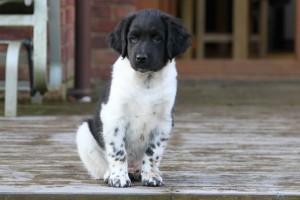 Hannah: There’s always a couple of puppies that you get really attached to – it’s hard to see those go! On the whole though, no, because they are so ready to go and start their new lives. Those who breed get to enjoy the cutest parts of a puppy’s life. We say goodbye when they’re starting to become little trouble-makers! It’s a bonus to be able to see how they grow up. You never forget a puppy.
Hannah: There’s always a couple of puppies that you get really attached to – it’s hard to see those go! On the whole though, no, because they are so ready to go and start their new lives. Those who breed get to enjoy the cutest parts of a puppy’s life. We say goodbye when they’re starting to become little trouble-makers! It’s a bonus to be able to see how they grow up. You never forget a puppy.
Janice: Not even slightly. I’ve said it before and I’ll say it again: By the time they’re ready to leave, I’m really ready to let them go. Same goes for Rikje.
Helen: Yes! I always have mixed emotions; sad that my babies are going but incredibly happy for their new owners.
Christina: Yes, but you are also very ready to see them go. Eight weeks is the ideal time for these little monsters to enjoy some one-to-one attention.
Q: What’s the best and worst thing about breeding a litter?
Christina: Seeing that first puppy born truly is magical. And then getting pictures and updates from their loving new families reminds you for weeks and months afterwards why you did it. The worst? The mess! There is no way around it; puppies are smelly. Kitchen roll is your best friend for a while.
Helen: The worst is losing one or having a still-born pup. The best thing is being able to keep one of the puppies myself.
Hannah: It’s amazing watching the birth, and seeing how they develop from being fat little sausages into little dogs. The worst – the mess! The sleep deprivation is hard for the first week or so, but that quickly passes.
Janice: It’s hard to come up with a worst thing, but puppy teeth is certainly in the running. But the best thing, hands down, is puppy cuddles. I’d brave all the puppy teeth in the world for those!




